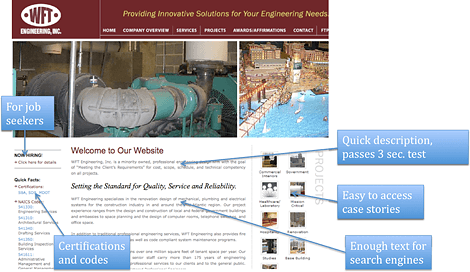After evaluating your current website, the next step in website planning is to evaluate the competition.
Keep in mind that your competition on the web may be different from who you think your competition is offline. To find your online competitors, do a Google search on industry terms and evaluate what firms are ranking in the top ten spots. If you are a construction firm, for example, you might search on terms such as “construction firms,” and “construction services.”
Now go through each of the top ten results in Google and take notes on each site. The idea here is to explore different options for your own site's design. Look for elements you like as well as weaker elements and write down your observations.
As you make your way through these sites, ask yourself the following questions:
- What is the main message the homepage is trying to convey? Is it obvious?
- What are the main navigation items? How is this site structured? Does a structure like this make sense for my site?
- What audiences is this site appealing to? Is it treating all visitors the same, or does it segment visitors down different pathways?
- What words and phrases does this site focus on? Will this terminology resonate with my visitors?
- What types of imagery stick out? What grabs my attention?
- How does this site incorporate social media? Is it a main priority, or is it subtle or non-existent?
- What types of educational content does this site have? Does it have a blog or other library items? What are they writing about?
- What are the offers and primary calls to action? Request a proposal? Download a white paper? Get started with a free trial? What makes sense for my site?
I like to use a basic PowerPoint file to keep track of my notes. You can take screen shots of competitors' websites and put them into slides. Then use call-out boxes to take notes. This will allow you to quickly go through the sites later and share them with your team. Here’s an example of what I’m talking about:

If you take the time to analyze competitors' sites it will help you plan your own website in three major ways:
- Sitemap Formulation — Seeing how other websites are structured and what pages they have in their navigation will allow you to begin developing your own structure.
- Message Differentiation — By evaluating the messaging from other sites in your industry, you get a sense for what’s out there. Knowing your competitors’ marketing messages makes it a whole lot easier to stand out from them.
- Online Dominance — Pulling the best elements from each website allows you to create the best of the best final product. Many people have put tons of work into these other sites. Go ahead and take ideas from these websites — then make them better.
You can find the first article in this series here: Website Planning Guide Part 1: Evaluate Your Current Site
Looking for more information on creating successful websites for your professional services firms? Get your free copy of Hinge's online marketing research study.
